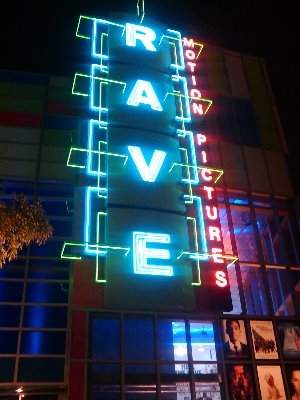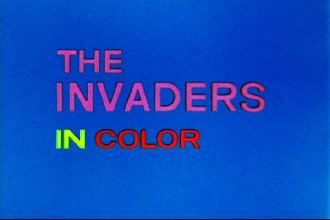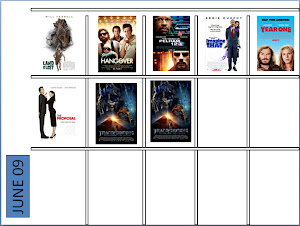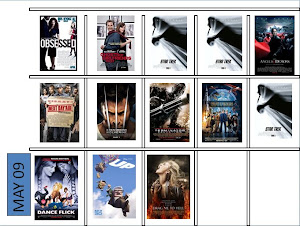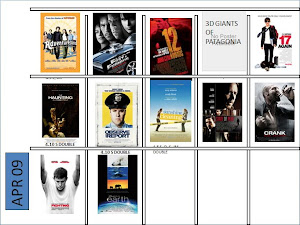Movie titles are always fun. Sometimes they’re precisely effective and you know exactly what you’re going to get when you sit down in the theatre (“Aliens” for example); sometimes not (“Outrageous Fortune”). It’s a specific point of audience recognition though, because many times moviegoers buying their tickets have nothing to go by except what they remember or mis-remember as the title. “Quantum of Solace”? That’s a tough one, gets short circuited to “The James Bond Movie.” “The Dark Knight” became “The Batman movie” (obviously) but also became “The BLACK Knight” (I didn't know Errol Flynn was still making movies...). With Leonardo DiCaprio’s REVOLUTIONARY ROAD out in theatres, it begs the question, how many of these addresses have you visited in your Hollywood vehicle? And how many people live in this crazy subdivision anyway? And how does the mailman ever figure out who gets what?

Saturday, January 31, 2009
Thursday, January 29, 2009
Wednesday, January 28, 2009
Opening Credits: The Terror
 Due to the compressed nature of the form, every component of a film is important. Filmmakers have approximately two hours to build a storyline, create predictability and anticipation, develop characters, motivations and goals, set the mood and tone, and introduce the audience to a world they may know little about. Many times credits are overlooked as a tool to set the mood of the film and are dropped in as an afterthought. Credits should be an integral part, and should speak to the nature of the film as much as anything else. An interesting use of opening credits is in the film THE TERROR (1978). A relatively forgettable horror film, the storyline involves a witch’s curse coming to bear on the descendants of the family at odds with the supernatural 300 years before. The movie turns into a standard “who gets killed next” pastiche and for the most part is only memorable for the way the credits are used to begin the film. Moments of mayhem in the movie are freeze framed, painted with various color tints, and set against eerie organ music (see image at right; click on the pictures to enlarge). The most effective part of the credits comes from the fact that the images aren’t clear; their coarseness suggests the sinister violence which is happening to the people shown, but we can’t actually determine what is happening which sets our imaginations into overclock mode. If only the rest of the film lived up to the luscious anticipation of the credits…
Due to the compressed nature of the form, every component of a film is important. Filmmakers have approximately two hours to build a storyline, create predictability and anticipation, develop characters, motivations and goals, set the mood and tone, and introduce the audience to a world they may know little about. Many times credits are overlooked as a tool to set the mood of the film and are dropped in as an afterthought. Credits should be an integral part, and should speak to the nature of the film as much as anything else. An interesting use of opening credits is in the film THE TERROR (1978). A relatively forgettable horror film, the storyline involves a witch’s curse coming to bear on the descendants of the family at odds with the supernatural 300 years before. The movie turns into a standard “who gets killed next” pastiche and for the most part is only memorable for the way the credits are used to begin the film. Moments of mayhem in the movie are freeze framed, painted with various color tints, and set against eerie organ music (see image at right; click on the pictures to enlarge). The most effective part of the credits comes from the fact that the images aren’t clear; their coarseness suggests the sinister violence which is happening to the people shown, but we can’t actually determine what is happening which sets our imaginations into overclock mode. If only the rest of the film lived up to the luscious anticipation of the credits…Tuesday, January 27, 2009
Sunday, January 25, 2009
Student Film Review of the Week
In my film studies class one of the things I teach my students is how to write contextual film reviews where they connect what they've learned about film structure, the movie business, and other films to a contemporary film we're studying. The goal is for them to be able to write publishable film reviews. The following stellar film review is from ALEX HIPSHER, Junior, Period 4, Rancho High School:
D.J. Caruso's action packed thriller EAGLE EYE serves up an all-star cast and non-stop thrills. And this is about all it does. The movie was written by a group of writers, who, judging by the product they churned out must be currently undergoing treatment for their paranoid schizophrenia and epinephrine addictions. EAGLE EYE strives to be a technical thriller that serves to warn of the dangers of Big Brother and total information control. However, the supposedly terrifying examples it serves up, such as a power line severing and landing in the perfect location to kill a disobedient enlistee, are so patently implausible, the viewer has to seriously wonder if he's in fact actually watching a comedy. The setting apparently takes place in a universe where a giant machine named Ariia has gained sentience and taken up the task of restructuring the status quo. Ariia is apparently the daughter of 2001's HAL 9000, as her actions mimic his very closely. She even has his eye. It's a wonder Ariia didn't drunkenly mumble showtunes during her eventual demise. One thing's for sure, producer Steven Speilberg can expect a lawsuit for plagiarism from whatever layer of Hell Stanley Kubrick currently films in. All in all, Eagle Eye is an action packed, but preposterously written thriller. Its lack of regard for suspension of disbelief and its geniune attempt to deliver some sort of high handed lesson ensure that no great injustice will be done when it is eventually relegated to a dank, dusty corner of a Blockbuster near you.
D.J. Caruso's action packed thriller EAGLE EYE serves up an all-star cast and non-stop thrills. And this is about all it does. The movie was written by a group of writers, who, judging by the product they churned out must be currently undergoing treatment for their paranoid schizophrenia and epinephrine addictions. EAGLE EYE strives to be a technical thriller that serves to warn of the dangers of Big Brother and total information control. However, the supposedly terrifying examples it serves up, such as a power line severing and landing in the perfect location to kill a disobedient enlistee, are so patently implausible, the viewer has to seriously wonder if he's in fact actually watching a comedy. The setting apparently takes place in a universe where a giant machine named Ariia has gained sentience and taken up the task of restructuring the status quo. Ariia is apparently the daughter of 2001's HAL 9000, as her actions mimic his very closely. She even has his eye. It's a wonder Ariia didn't drunkenly mumble showtunes during her eventual demise. One thing's for sure, producer Steven Speilberg can expect a lawsuit for plagiarism from whatever layer of Hell Stanley Kubrick currently films in. All in all, Eagle Eye is an action packed, but preposterously written thriller. Its lack of regard for suspension of disbelief and its geniune attempt to deliver some sort of high handed lesson ensure that no great injustice will be done when it is eventually relegated to a dank, dusty corner of a Blockbuster near you.
Saturday, January 24, 2009
Friday, January 23, 2009
Thursday, January 22, 2009
Homemade Double Feature

Peanut Butter and Jelly Pick of the Week. Two movies that really should be watched together with the lights down low and the surround sound turned up: SHOCK WAVES and THE OUTPOST. Both swim around in the same horror sub genre of secret nazi experimentation gone bad. SHOCKWAVES has been called “the best of the Nazi zombie movies.” Peter Cushing stars in the story which combines a deserted island, genetic experimentation, and a few hapless, trapped shipwrecked travelers. It has a great deal of creative energy in it, if not budget. Along the same lines, THE OUTPOST borrows from the mercenary tradition of PREDATOR. Soldiers are hired to transport a businessman to a forgotten underground bunker in order to secure Nazi science based on unified field theory. Of course, there’s more waiting for them than some creaky, rusty equipment. What may be the most interesting thing about THE OUTPOST is its genesis -- the film was produced by Scottish couple Arabella Croft and Kieran Parker and their production company Black Camel Pictures. They mortgaged their Glasgow home in order to raise £200,000 to finance production. Typically, these kinds of boutique endeavors turn out narcissistic productions, but in this case, while it does borrow liberally from other movies, the effort is sincere and aimed toward telling its story, and could in fact have been produced in Hollywood and released in theatres as opposed to a straight to DVD release, as it was picked up by Sony for distribution. The cinematography, sound, and production design adds great depth. Acting is solid.
Wednesday, January 21, 2009
Tuesday, January 20, 2009
Movie Homework

A friend of mine, Ralph Rosati, has a preference about his previews. He likes at least three but no more than six. Less than three and he feels cheated. More than six and it dilutes the tantalizing morsels of expectation and gets to be – even as much as fun as previews are -- tedious. I agree. So while you’re waiting for your movie to start, watching The Twenty or whatever preshow your theatre uses, before the Coca Cola and AXE and ETrade and cell phone commercials and the National Guard music video are over, try this game to pass the time (if you’re like me, you like to get to the theatre early to get that Tomlinson Holman seat. More about what that is later.) Anyway…here's the game: see if you can guess which previews are going to be shown before your feature. Easy, right? Two rules: you have to announce your stunningly psychic choice proudly, and you have to solidify your choices before the previews begin (no changing your mind after the rabbit is out of the gate). Base your decision on context: the more you know about movies, the easier the game gets, but it never gets easy. Rating is important; impending releases are important; obviously genre and intended audience (not too many horror movies previewed in front of Bolt – makes sense) are important; stars are important, time of year is important, even which studio is distributing the feature is important. But you have to narrow your choice to only three. And then judge your success (or failure) on your “batting average.” Three out of three is sensational (how many major league baseball stars bat 1000 is any one game?) -- one of three is a good start. Zero? Maybe you need to do more homework before you go to the movies next time…
Tuesday, January 13, 2009
Have You Got One? Or Two? Or Three?
Film relics. If you’re a true movie fan, cinephile, movie follower, cinema-goer, aficionado, devotee, enthusiast, adherent, or addict, then someplace in your personal universe you’ve got at least one film relic. Something from a film that you thought was sooo cool you had to pay real money for it and display it for your personal satisfaction (and sometimes public criticism). Maybe it’s a picture of your favorite character, or a prop, or a poster of your favorite movie. Within films, things take on meaning in order to tell their stories; in our lives, things from films take on meaning for us: they remind us where were we when we saw it, when was it, who we were with; they offer a touchstone from a moment when maybe we discovered something about ourselves or something else; give us a remembrance of some small epiphany; remind us when we found a small truth that added to our lives. Maybe you have a holy grail of film relics that if you just had enough money or just had enough connection with the right people you could get your hands on -- one which you would display prominently over your widescreen tv which enables you to watch movies in their most pristine, closest- to- film-experience- we- can- get- at- home glory. Mine? Easy. A prop rifle from PLANET OF THE APES. But until I get my hands on that one, I guess this one will have to be my crown jewel, an accidental movie relic I acquired with the help of my son.
Monday, January 12, 2009
No Oscar For Gran Torino?

GRAN TORINO: definitely the best movie so far of 2009. Well directed, well acted, superb story. Entertaining throughout. Perhaps even better than 2008's, and that’s saying a lot, putting it in front of BENJAMIN BUTTONS, SLUMDOG MILLIONAIRE, yes, even perhaps past THE DARK KNIGHT. 2008 was a solid year for good films, true, and this is definitely a must see. The trailer for GRAN TORINO doesn’t reveal the depth or emotional range that this film fathoms, and it’s no surprise how well this story is told: Clint Eastwood has been doing this long enough to know how to work a story into its own weight and let it stand for what it is. He’s been acting in movies since 1955 (REVENGE OF THE CREATURE), directing since 1971 (THE BEGUILED) and producing since 1982 (FIREFOX). What is that, like, fifty years in show business? They say it takes 15 years of serious study to be an expert in a field; he's qualified to be a three time expert in three different areas...
Saturday, January 10, 2009
Does Size Matter?
How many times has this happened? You see a movie in the theatre, and it’s great. I mean, really great. In fact, you’re certain that this is the best movie ever made, maybe. And then, three months or so later, the movie comes out on dvd, and you rewatch it, sans 60 foot screen and million dollar sound system and you realize something’s not right; the great masterpiece you acknowledged as you left the theatre suddenly seems, well, average, maybe even mediocre, or worse yet, bad. Like, how could I have ever thought this thing was good bad. Several years ago when I was working as a projectionist, I had a friend who labeled this “the 9 to 5 syndrome.” He had seen 9 to 5 at the movie theatre, loved it, and then months later watched it on network tv, expecting to enjoy it as he did in the theatre, only to discover that he very nearly hated it. When it was shown on tv, the network had done the unthinkable: panned and scanned the picture, reducing the widescreen ration to 4:3. I took a more global view of the situation: it’s not just the pan and scan; size matters in a person’s critical awareness of a film, because the visceral impact is lessened with a shrinking image size. Being in the theatre with giant subwoofers and surround sound enveloped in darkness with only one thing to focus on (that 60 foot image) puts your senses in heightened alert. The movie slams it into your subconscious at a hundred miles an hour and your critical reservoirs flashflood out. Sometimes just looking at a car going by or a beautiful woman in the movie theatre is enough to make you think you're looking at the next Mona Lisa... (Add to this an interesting inverse rule component: a person’s “critical” sense grows as the size of the viewing screen shrinks and the number of sound channels decreases. Lose stimulus input and you distill a movie down to its basics: storyline. No smoke. No mirrors. No flash. When I was at USC, in one of our sound classes we watched two cuts of RAIDERS OF THE LOST ARK and STAR WARS to emphasize the sound factor. One without sound, one with it. Without sound, the Star Wars opening credit crawled along (or seemed to) as well as the speed at which Indiana Jones escaped the booby traps protecting the golden idol. Try it.) There is a simple – if unproven -- logic to it: the smaller the image, the lesser emotional impact it can have because of the limited amount of stimulus it provides…
Wednesday, January 7, 2009
Monday, January 5, 2009
 The other night I was watching HAIR, and I was struck by the structural / thematic nearness of this film to the more recent ACROSS THE UNIVERSE. In my film studies class, we analyze film according to decade, identifying dynamic characteristics, influences, changes, and popularity, keeping in mind internal structural changes within the Hollywood "machine" that causes one film to be made over another. When we get to the 70’s, we discuss the “rock opera” and how it becomes a genre unique to the twentieth century art of filmmaking, combining music originating in the 50’s with the experimental / artistic film muscle of the 70’s. The question always arises, what is the first rock opera, and how do we define it? Ultimately the argument of what to include and what not to include (categorically speaking) pivots on quantitative and qualitative issues: how much does the music tell the story (as opposed to dialogue), and just what constitutes rock music itself. I.e., at what point does a rock opera become a rock opera and not just a musical? There’s not much argument that the first “true” rock opera is Jesus Christ Superstar (1973) followed by Tommy (1975) by the Who, and later Quadrophenia (1979) (also by the Who). But what about Yellow Submarine and Sgt. Pepper’s Lonely Heart’s Club Band? (featuring music by the Beatles) or Across the Universe (also featuring Beatles’ music). What about Mamma Mia (ABBA)? Merriam Webster’s online dictionary defines opera as “a drama set to music and made up of vocal pieces with orchestral accompaniment and orchestral overtures and interludes.” Not much help there; my inclination is that a) the music must play a large role in the movie and also progress the storyline in a direct manner and b) the music must be rock music. This tends to leave out Elvis movies (not because of type but because songs are relatively interchangeable) but definitely includes Moulin Rouge (which features all kinds of rock music).
The other night I was watching HAIR, and I was struck by the structural / thematic nearness of this film to the more recent ACROSS THE UNIVERSE. In my film studies class, we analyze film according to decade, identifying dynamic characteristics, influences, changes, and popularity, keeping in mind internal structural changes within the Hollywood "machine" that causes one film to be made over another. When we get to the 70’s, we discuss the “rock opera” and how it becomes a genre unique to the twentieth century art of filmmaking, combining music originating in the 50’s with the experimental / artistic film muscle of the 70’s. The question always arises, what is the first rock opera, and how do we define it? Ultimately the argument of what to include and what not to include (categorically speaking) pivots on quantitative and qualitative issues: how much does the music tell the story (as opposed to dialogue), and just what constitutes rock music itself. I.e., at what point does a rock opera become a rock opera and not just a musical? There’s not much argument that the first “true” rock opera is Jesus Christ Superstar (1973) followed by Tommy (1975) by the Who, and later Quadrophenia (1979) (also by the Who). But what about Yellow Submarine and Sgt. Pepper’s Lonely Heart’s Club Band? (featuring music by the Beatles) or Across the Universe (also featuring Beatles’ music). What about Mamma Mia (ABBA)? Merriam Webster’s online dictionary defines opera as “a drama set to music and made up of vocal pieces with orchestral accompaniment and orchestral overtures and interludes.” Not much help there; my inclination is that a) the music must play a large role in the movie and also progress the storyline in a direct manner and b) the music must be rock music. This tends to leave out Elvis movies (not because of type but because songs are relatively interchangeable) but definitely includes Moulin Rouge (which features all kinds of rock music).
Subscribe to:
Comments (Atom)













